|
LevelHead's SWS project
Leupold Mark IV 16X
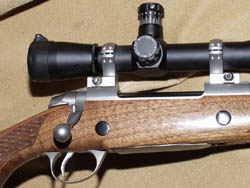 |
Mark IV mounted on my Sako 7mm Rem Mag |
Long before this project began I had purchased a Leupold Mark IV 16X scope and put it on my Sako Elk gun. Why? I have no idea. I'd guess heard great things about the Mark IV and having had other Leopolds, figured that their flagship scope had to be top notch. At any rate I had a Leupold Mark IV "laying around" and with a new SWS in play, decided it was time to put it where it belong. Of course this would entail buying a new silver scope to match my Sako, but that's a tale for another time...
Having owned other Leupold scopes in the past, I was familiar with their quality and ruggedness. The Mark IV is no exception. Some say they are so tough you can pound nails with them, but I'll leave that for them to try. The finish on the Mark IV is matt black, and it is one of the few scopes made by Leupold that does not have their signature gold ring around the objective.
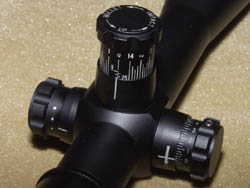 |
Mark IV M1 Turrets |
The controls are 1/4 MOA for both windage and elevation. The knobs are pretty large and are easily grabbed while wearing gloves. The markings are also easily visible in most lighting conditions. As I understand it this scope (The 16X variety) was designed for use on long range .50 BMG rifles. This design is evident in a number of features. First, the 1/4 MOA adjustments. 1/4 MOA is pretty fine for a sniper scope, which is what the Mark IV is after all, but consider that 1 MOA at 1000 yards is roughly 10 inches and you can understand why the 1/4 adjustments are there. Remember, this scope is designed for .50 BMG long range applications. The knobs are able to be re-zeroed by removing a small allen screw.
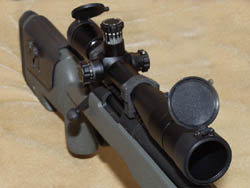 |
Mark IV M1 Turrets |
Another nod to the long range shooters is the huge amount of internal adjustment this scope is capable of. For a normal scope to dial from 100 to 1000 yards, a 20 MOA forward cant base is required because the internal mechanism of a normal scope simply will not move far enough for such a wide change in range. The Mark IV 16X has 140 MOA of internal elevation adjustment. As a reference, the standard Mark IV has an internal adjustment range of about 70 MOA. Due to the extended elevation possibilities in this scope, I was able to use a flat base.
The Mark IVs come with a sunshade which screws on to the objective (A nice touch since they are ususlaly ~$40 extra), and also comes with butler creek flip up scope covers. The scope ships in a very tactical looking black box. You can never be too "tactical" you know...
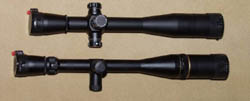 |
Mark IV next to a 8x25x40 AO Vari-X III |
Compared with a "normal" Leupold scope, the Mark IV is thicker and possible shorter. The Mark IV has a 30mm Main tube which is required for the extended adjustment range. One might be tempted to think that a 30mm tube lets more light through, but the amount of light let in is really a factor of the objective size and where the light focuses in the tube. The glass is all fully multicoated and is supposed to be sharper edge to edge then a "normal" scope, but my eyes can't tell the difference. Of course I've never needed to resolve small details at the edge of my view either. Notice also that the focus knob is located on the side of the scope as opposed to the bell of the objective. This is to simplify operation and to allow adjustment without changing position while prone. It works very well.
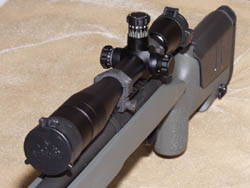 |
Another view of the Mark IV on my Rem 700 with McMillan A4 Stock and Badger rings |
Eye Relief is good if a little tight. What I mean by tight is that while the eye relief is a generous four inches, you must be exactly in the right spot for the scope picture to be properly viewed. This is not a problem if you have a genuinly repeatable cheek weld, but it bugged me at first before I got used to it or got better at my cheek weld - I'm not sure which.
The reticle of choice is the mildot. There is not enough space here to explain mildots. Suffice to say they are the choice of snipers worldwide for ranging targets. I'm not sure they work for me, but I've not spent enough time ranging unknown distances with them to say for sure. One thing I can recommend is to get yourself a Mildot Master. This handy little calculator removes most of the math from your sidtance calculations making the MilDot a much easier tool for use in the field. Of course if you could do all the math in your head you wouldn't have to worry about losing or forgettng your Mildot Master...
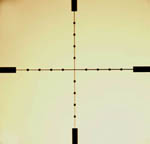 |
Actual view of the Mildot reticle as seen through this MArk IV |
The Mildot Reticle is show here. This image by the way is an actual picture through this scope, which I'd like to add is not very easy to do.
There is a great deal of people who say this rifle should not have a 16X scope on it. The argument states that for a sniper rifle, field of view is just as important as magnification. A sniper should have the ability to identify targets and threats which are not necessarily in the center of the scope's view. Since lower magnification means a wider field of view, the 10X is the perfect compromise between the two. While I agree with this agrument for snipers in the field, for me at least and my slowly eroding vision, 16X is a WHOLE lot more pleasent to shoot with at the range. To me if its not fun - don't do it. The 16X makes this rifle more fun to me. That being said, if and when I do upgrade to a USO scope, I'll probably end up getting the 10X. Then again they do sell a 17X...
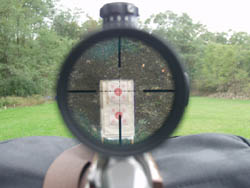 |
Actual view of a sighting target through the Mark !V 16X at 100 yards |
I know this review wasn't very technical and probably wasn't very useful to those wondering if they should buy a MArk IV, but I can tell you that I've been very happy with this scope at 100 yards. I'm pretty sure that I would be happy with this scope at 1000 yards as well. Where I think it would break down is shooting at unknown distances between the two. The 1/4 MOA adjustments would become tiring over that much variation in distance. I think for a true sniper that may encounter 100-1000 yard shots (or more), the knobs which offer one complete rotation to 1000 yards would be an excellent choice.
Needless to say the actual sight picture through the scope is substantially better than anything I've managed to capture with the camera.
|
|







